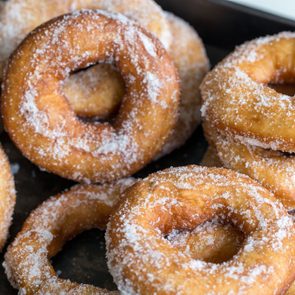Are the New Gluten-Free Oreos Actually Healthy?
Updated: Jul. 18, 2022
Gluten-free Oreos are on the horizon. Are they healthier, or just another cookie? Nutritionists weigh in on the new cookie.
All about gluten-free Oreos
Talk about a sweet Tweet. The makers of Oreo cookies are going gluten-free, tweeting on November 16, “Milk’s Favorite Cookie, now in a gluten-free version. Coming January 2021.” (There will actually be two gluten-free versions: traditional and Double Stuf.)
Twitter followers erupted with joy. “Best thing to ever happen,” tweeted one joyful follower. “Game changing,” gushed another.
But is it really? “It depends,” says Amanda Beaver, RDN, a wellness dietitian with Houston Methodist Wellness Services. “If you have celiac disease or non-celiac gluten sensitivity, these are a better choice. But for everyone else, it is likely not. It is not automatically healthier for you just because it does not contain gluten.”
Here’s what nutritionists want you to know about gluten-free Oreos and whether they’re actually a healthier alternative to regular Oreos. (Also, here’s the hidden risk of a gluten-free diet.)
What is gluten?
Gluten is an umbrella term for proteins found in various grains, most notably, wheat, rye, and barley, according to the Celiac Disease Foundation. It serves a clear purpose as a “binding agent” (helping to hold food together and keep its shape) while also enhancing texture and sealing in moisture and flavor, according to research in the journal Gastroenterology and Hepatology. And, as a protein, it also has nutritional value.
It’s a surprisingly widespread ingredient. You can expect to find gluten in the usual places (like bread, baked goods, pasta, and cereals). But it’s also found in soups, salad dressings, malted milkshakes, malt vinegar, and soy sauce. And it turns up in other grains like wheat berries, semolina, farina, and triticale, too. (Here are more foods with gluten that will surprise you.)
Is gluten bad for your health?
Again, it depends. If you have celiac disease, and about one percent of the world’s population does, ingesting gluten may unleash an immune response that can cause serious damage to your small intestine. Gluten may also cause symptoms in people who don’t have celiac disease but are still sensitive to gluten.
“If someone is intolerant of gluten, it is best to avoid gluten at all cost,” says Savanna Latimer, RD, a nutritionist with Ochsner Medical Center in Baton Rouge, Louisiana. “Even one original Oreo could trigger a response with someone with extreme gluten intolerance or celiac disease.”
Does gluten mean more healthy?
For people who aren’t intolerant, gluten may actually be healthy. It may act as a prebiotic, nurturing the “good” bacteria in your gut.
What’s more, gluten-free products may also deprive you of nutrients. “In general, I don’t recommend gluten-free versions of regular foods like muffins, pasta, snacks, and bread as they often contain less protein, fiber, and vitamins,” says Beaver. “And they may have more sugar and fat to compensate – making them a less healthy choice.”
Despite the glut of gluten-free foods out there, “there’s really no reason to avoid it,” Beaver says. “It has caught on as a little bit of a fad outside of the community that needs it medically. People think of it as white bread, but it’s actually a protein. We all think of protein as a good thing.”
Milk’s Favorite Cookie, now in a Gluten Free version. Coming January 2021. pic.twitter.com/2wbBB5MpwQ
— OREO Cookie (@Oreo) November 16, 2020
So, are the new gluten-free Oreos healthier?
Classic Oreos, says Latimer, “are quite possibly the polar opposite of what we recommend as a nutritious, nourishing, wholesome snack. [They’re] filled with white flour and a spoonful of added sugar.” Specifically, three cookies pack 160 calories and 14 grams of added sugar.
Mondelez International, which makes Oreo, released information on the ingredients in the new gluten-free Oreo. They say the cookies should deliver a “comparable snacking experience to the original recipe.”
“It really isn’t any better than the original, simply because it’s gluten-free,” says Latimer. “It’s still essentially sugar, refined flours. Sure, it may be better tolerated by people with gluten intolerance or sensitivity. But let’s be honest: It’s still just a cookie.”
Can Oreos be part of a healthy diet?
Let’s also be realistic. “Oreos are a crowd-pleaser,” says Latimer. “If you’re looking to indulge, just be mindful of the serving size (three cookies).” And brush up on the guidelines for really healthful eating. That means a focus on lean proteins, fruit, vegetables, and whole grains while limiting foods with high sugar and enriched grains.
The gluten-free Oreo, Double Stuf or regular, may not be the healthiest snack in the world but for people with gluten sensitivity, it may also be a way to participate in a uniquely American ritual.
“Twisting open an Oreo and deciding what to eat first is a defining joy of American childhood,” says Marilyn Geller, CEO of the Celiac Disease Foundation. “Now children and adults with Celiac disease can experience that special, wonderful, always-right decision.”





















